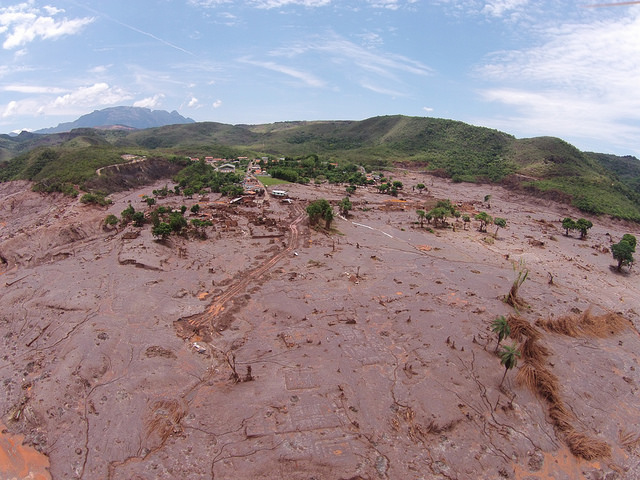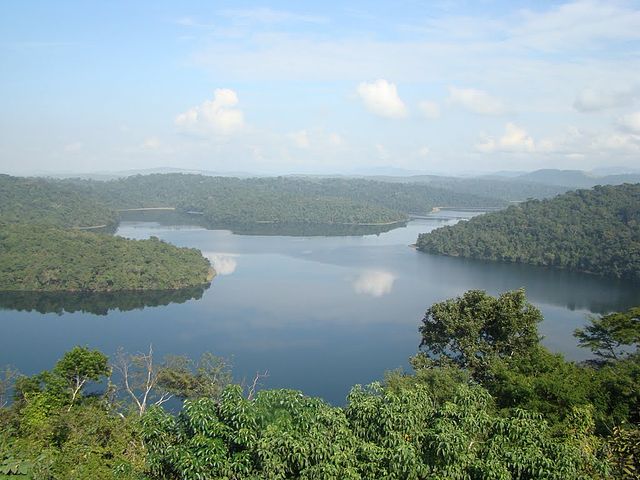- Despite the magnitude of the disaster, the cause for the break isn’t clear yet.
- Environment minister Izabella Teixeira has estimated the recovery of the Doce River region to take at least ten years, if at all possible.
- Some state institutions say they’ve found residues of heavy metals in the mud: high levels of manganese, aluminum, and iron oxide.

Earlier this month, the Fundão dam in the state of Minas Gerais broke, starting the biggest environmental disaster in the country. Since then, the possibly 62 million liters of toxic mud travelled around 600 miles, transforming the Doce River into a pot of dust, killing most of its biodiversity.
The tsunami did not only cause biological damage: so far, 11 people have died, dozens are missing and 500 are left homeless. The water supply in the cities along the river’s path has been interrupted.
The mud has been traveling along the river and is expected to reach the Atlantic Ocean contaminating the sea, according to André Ruschi from the biological institute Estação Biologia Marinha Augusto Ruschi.
“Every time there’s heavy rainfall, the mud will descend into the ocean and spread from an area of over 1,000 m² in the north coast and around 3,000 m² in the south,” explained Ruschi to Mongabay in an email. “The entire food chain of one-third of southeastern Brazil is compromised and will not be functional for at least another 100 years.”
The Fundão dam is controlled by the Samarco mining company, a subsidiary of Brazil’s Vale and Anglo-Australian BHP Billiton. Despite the magnitude of the disaster, the cause for the break isn’t clear yet. Two small earthquakes happened in the region hours before the disaster, according to the Observatório Sismológico at the University of Brasília. But if there is a connection between the tragedy and the earthquakes, it is yet to be proven. What some experts do believe, is that structurally, the dam was in a precarious condition to begin with.
Along its course, the Doce River is home to various indigenous communities. Last weekend, the Krenak tribe protested the closing of a highway around the river; 350 people, they said, depended on the river for water and food. But since the disaster, mud has replaced fresh water along the river path, and specialists say the absence of oxygen is killing the once abundant fish species that lived in Doce. “If the river dies, we all die,” said Geovane Krenak, chief of the tribe.
The Brazilian government has stated that it will hold Samarco and Vale responsible for the tragedy. BHP Billiton chairman Jac Nasser has so far committed $363 million to rebuild the affected areas.
The so-called tailings dam is used to store the waste from Samarco’s mining operations. In a press conference held earlier this month, company representatives also admitted the possibility of disruption in two other dams, Santarém and Germano, located close to the one that collapsed earlier this month; they revealed the Santarém dam has a stability of only 37%, and the situation at the Germano dam is even worse.

Mud could be toxic
The mining company has ensured that thee muddy runoff containing 70 billion liters of iron released during the accident is not toxic. According to Samarco’s spokesperson, the waste consists of sand and other chemical elements that are not harmful to human health.
But some state institutions say they’ve found residues of heavy metals in the mud. The Water and Sewer Service in the city of Governador Valadares points to an iron index that’s more than 1.366.666% “beyond the recommended levels” along with high levels of manganese, aluminum, and iron oxide.

Recovery could cost $5 billion
Environment minister Izabella Teixeira has estimated the recovery of the Doce River region to take at least ten years, if at all possible. “We know that large native populations of reptiles and fish were lost. The recovery of the remaining populations is fundamental for the maintenance of the environmental quality in the basin,” said Teixeira.
Even without the presence of heavy metals, the mud is also causing profound damage to the soil. “The roots will be under the sand and because of that, certainly, all the plants in contact with this mud will die off,” affirms Francisco Barbosa, professor of the Biomedical Institute of Minas Gerais Federal University.
The river is also an important driver of nutrients into the ocean. The mouth of the Doce River is one the most important fish spawning areas in the world, according to Ruschi. “All the big fish from the northern and southern hemisphere come here to reproduce. With the arrival of the mud possibly containing toxic waste, a lot of these species and a big chunk of the ocean will become negatively, and irrevocably, affected.”
In the short term, Barbosa says that heavy rains could dilute the mud into the water. But in the longrun, recovery could take from 20 to 30 years. A lot of the animal species will probably disappear “hopefully only locally,” he added.
Last week, Greenpeace activists protested in front of the Samarco QG in Australia, demanding an explanation for the tragedy. According to the NGO, Samarco didn’t have a proper contingency plan and also didn’t warn local residents on time.
As far as Brazil’s federal government goes, its response was also delayed and remains insufficient. Authorities interviewed by Mongabay say they need more time to elaborate a plan to improve the monitoring of large-scale mining operations, but haven’t specified how.














